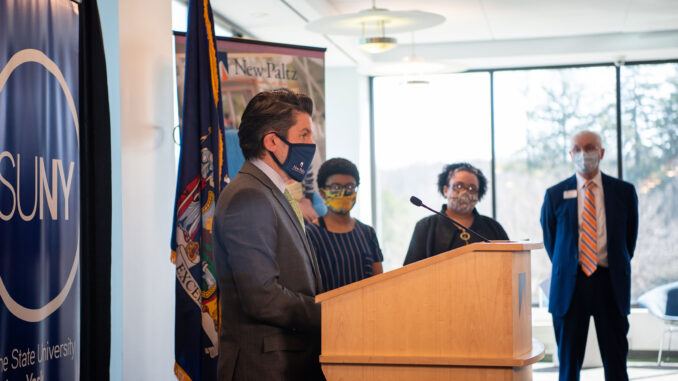
On March 23, SUNY Chancellor Jim Malatras announced 72 new full-time faculty hires as a part of SUNY’s Promoting Recruitment, Opportunity, Diversity, Inclusion and Growth (PRODiG) Initiative to increase diversity on its campuses.
Of the 72 new hires, eight are members of New Paltz’s PRODiG cohort for the 2020-21 academic year.
They are Adolfo Bejar Lara (Languages, Literatures and Cultures),Latanya Brandon, (Teaching and Learning) Matthieu Chapman,=(Theatre Arts) Aurora De Armendi, (Art);Asilia Franklin-Phipps(Teaching and Learning) Christina Koehne,(Mathematics); Ethan Madarieta, (English) and Ramon Vasquez, (Teaching an Learning).
The PRODiG initiative is aimed at increasing the representation of historically underrepresented groups in professorships on campus, including women of all races in STEM faculty positions. The program is in its second year, and has led to 149 faculty amongst 31 SUNY campuses being hired, and has continued to increase faculty diversity, and with underrepresented new hires up 36% year over year.
“These individuals represent the best and brightest the university system and that this nation has to offer,” said SUNY Chief Diversity Officer TeresaMiller. “Our campuses considered applications from outstanding scholars and researchers from every region of this country and across myriad disciplines and inclusive of all demographics. We are excited about the innovation, creativity and leadership these new SUNY faculty will bring into our classrooms and research labs throughout the system.”
SUNY’s data demonstrates a need for more diverse faculty as the student body becomes more diverse each year.
According to a SUNY press release from March 23, Black and Hispanic faculty only represent about 4% and 3.4% respectively, indicating the need to hire more diverse faculty.
“Our data reveals a pronounced gap between the racial/ethnic diversity of SUNY faculty members (8.6%) as compared to the diversity of the students they instruct (28.5%, Fall 2018),” states the SUNY PRODiG website.
This gap is expected to grow over the years.
The criteria for the cohort included holding a tenure-track, full-time position, being a member of a historically underrepresented group and/or a woman teaching and/or researching in a STEM+H (science, technology, engineering, math and health) discipline and have started after June 30, 2020, but before July 1.
Faculty in the PRODiG cohort gain access to a network of colleagues across all of the SUNY campuses and are eligible to further professional development through the SUNY Office of Diversity, Equity & Inclusion. In addition the salary support allows New Paltz to reposition itself and invest in further initiatives to improve the campus, its inclusion and retention.
“One of the longest standing and most unfulfilled challenges facing higher education is to diversify the workforce of the academy and to create learning and working environments that are equitable and inclusive so that every member of our community can achieve their full promise,” said President Donald P. Christian in a press release. “PRODiG has created a framework and offered funding for intentional and sustained change and helped us take bigger and bolder steps in our journey to be a more inclusive campus.”
It’s not just the professors and faculty themselves who benefit from this initiative, but the students, too.
The Association of American Colleges & Universities (AACU) reported that the National Center for Education Statistics (NCES) found that in 2008 just under 20% of the nation’s professoriate consists of people of color (POC).
Yet, according to a 2017 report by Pew Research center not much has changed. Just 24% of postsecondary faculty were POC, and POC made up 45% of the student body.
“Growing up in a white part of town as a Black individual is hard — it wasn’t until SUNY New Paltz where I saw multiple Black professors, especially in the field I want to pursue,” said Jadzia “JJ” Devis, a theatre arts major. “Having a diverse faculty on all campuses and in all fields is important, as it helps current students complete their degree and become notable alumni. Seeing and getting to know professors of color who teach in my major and are accomplished is extremely inspiring and lets me know there is a greater chance for me to succeed regardless of my skin color.”
